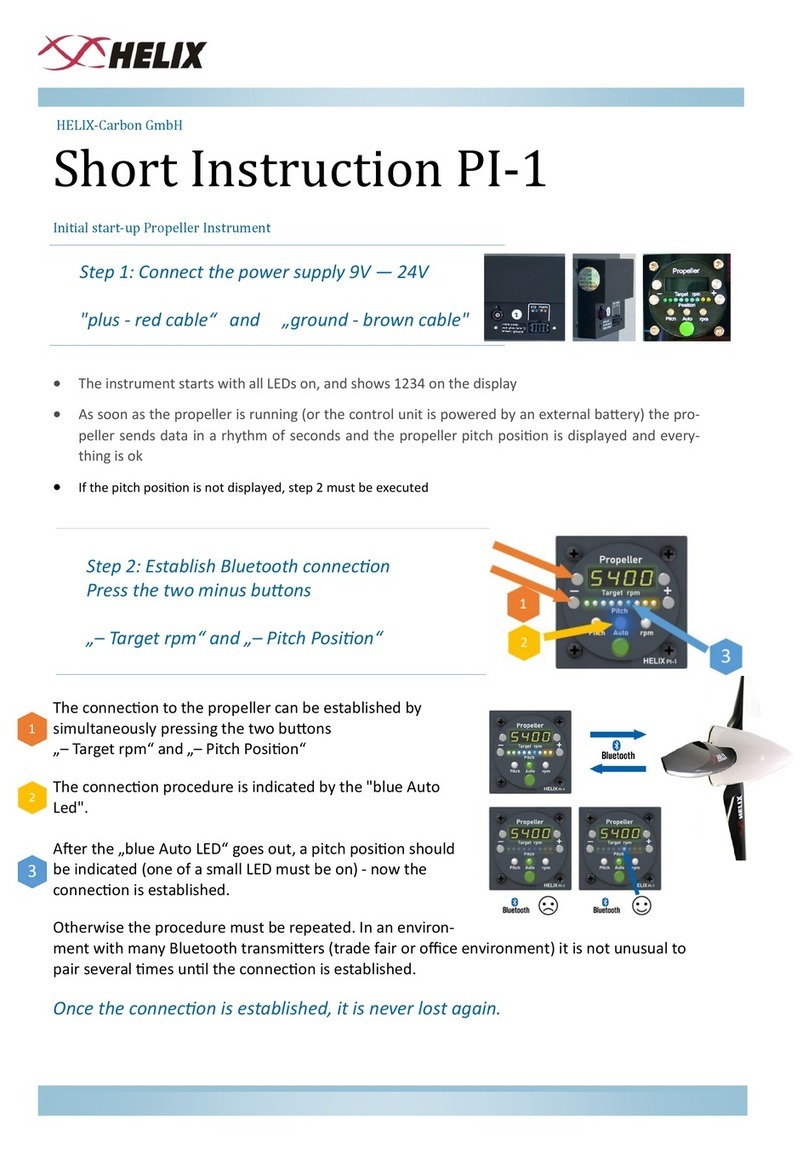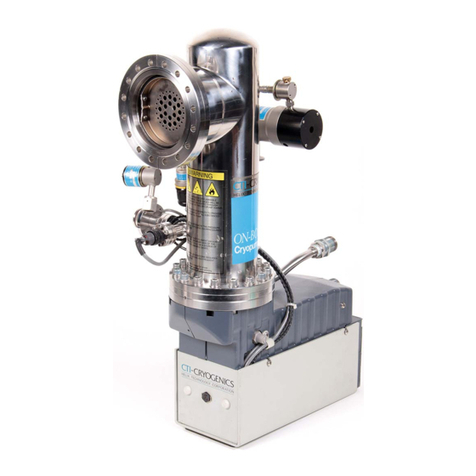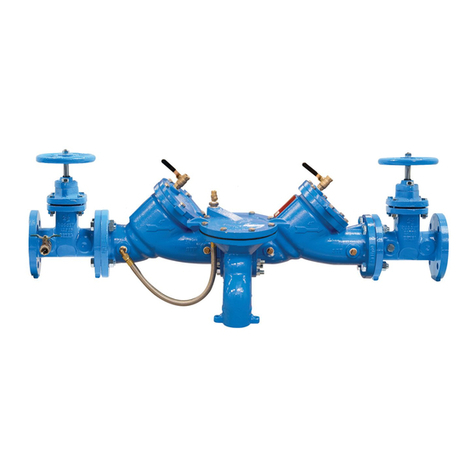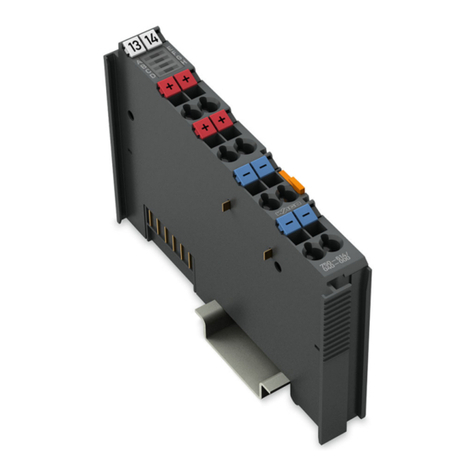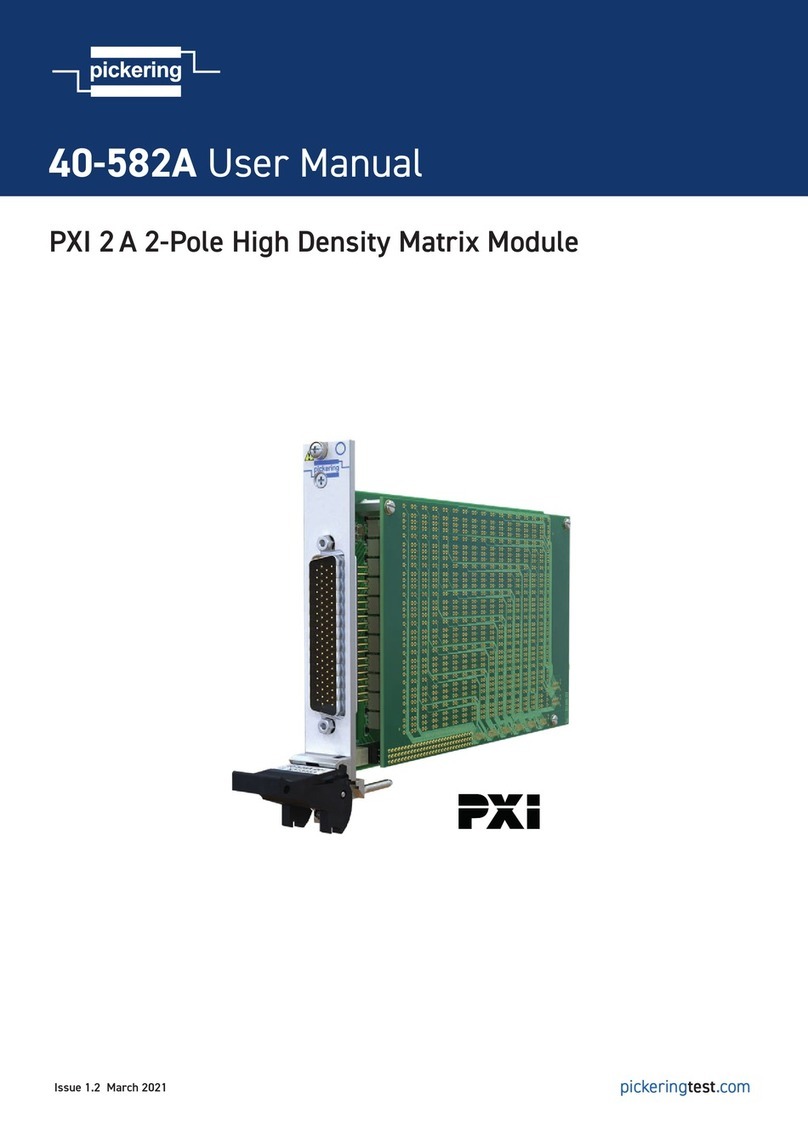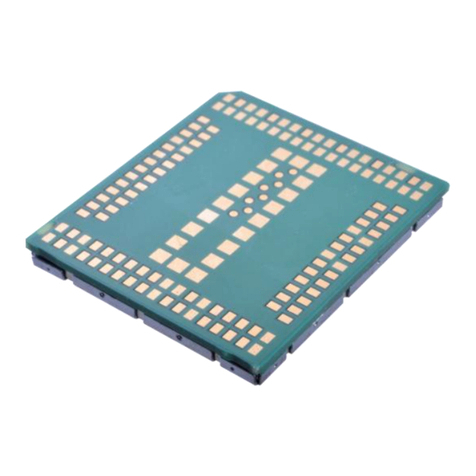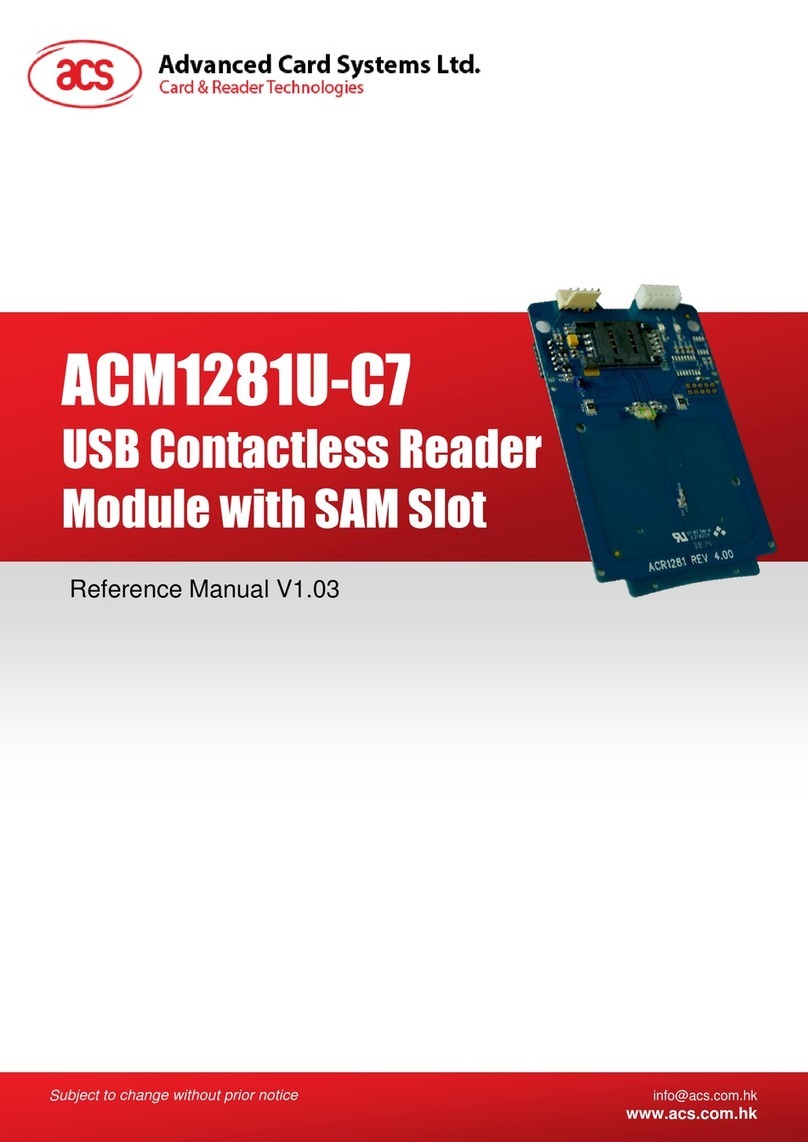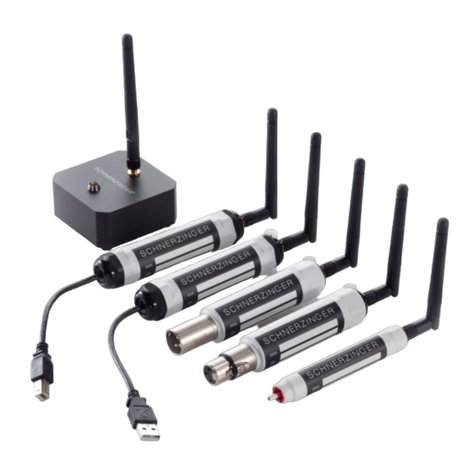HELIX GRANVILLE-PHILLIPS Convectron ATM User manual

GRANVILLE-PHILLIPS
HELIX TECHNOLOGY CORPORATION
Convectron®ATM
Vacuum Gauge Module
Instruction Manual
Instruction manual part number 385004
Revision 01
September 2004


GRANVILLE-PHILLIPS
HELIX TECHNOLOGY CORPORATION
To order products online, email www.helixtechnology.com
For customer service, 24 hours per day, 7 days per week, every day of
the year including holidays, toll-free within the U.S.A., phone
1–800–367–4887
For customer service within the U.S.A., 8 AM to 5 PM, weekdays
excluding holidays:
• Toll-free, phone: 1–800–776–6543
• Phone: 1–303–652–4400
• FAX: 1–303–652–2844
© 2004, Helix Technology Corporation. All rights reserved.
Convectron is a registered trademark of Helix Technology Corporation. Granville-Phillips
is a trademark of Helix Technology Corporation. All other trademarks and registered
trademarks are the properties of their respective owners.
Convectron®ATM
Vacuum Gauge Module
Instruction Manual


Convectron®ATM Vacuum Gauge Module Instruction Manual i
Contents
Chapter 1 Before You Begin . . . . . . . . . . . . . . . . . . . . . . . . . . . . . . . . . . . . 1
1.1 About these instructions . . . . . . . . . . . . . . . . . . . . . . . . . . . 1
1.2 Caution and warning statements . . . . . . . . . . . . . . . . . . . . . 1
1.3 Reading and following instructions . . . . . . . . . . . . . . . . . . . 2
1.4 Definitions of terms . . . . . . . . . . . . . . . . . . . . . . . . . . . . . . . 3
1.5 Customer service . . . . . . . . . . . . . . . . . . . . . . . . . . . . . . . . 3
Chapter 2 Installation . . . . . . . . . . . . . . . . . . . . . . . . . . . . . . . . . . . . . . . . . . 5
2.1 Module components . . . . . . . . . . . . . . . . . . . . . . . . . . . . . . 5
2.2 Installation procedure . . . . . . . . . . . . . . . . . . . . . . . . . . . . . 6
Step 1 Install pressure relief devices . . . . . . . . . . . . . . . . . . . . . . . . 7
Step 2 Locate and orient module . . . . . . . . . . . . . . . . . . . . . . . . . . 7
Locate the module . . . . . . . . . . . . . . . . . . . . . . . . . . . . . . . 7
Orient the module . . . . . . . . . . . . . . . . . . . . . . . . . . . . . . . 8
Step 3 Attach module to vacuum chamber . . . . . . . . . . . . . . . . . . 9
1/8 NPT pipe thread . . . . . . . . . . . . . . . . . . . . . . . . . . . . . . 9
VCR type fitting . . . . . . . . . . . . . . . . . . . . . . . . . . . . . . . . . . 9
KF flange . . . . . . . . . . . . . . . . . . . . . . . . . . . . . . . . . . . . . . . 9
ConFlat flange . . . . . . . . . . . . . . . . . . . . . . . . . . . . . . . . . . . 9
Step 4 Assemble and connect wiring . . . . . . . . . . . . . . . . . . . . . . . 10
Connecting cable . . . . . . . . . . . . . . . . . . . . . . . . . . . . . . . . 10
Wiring terminals . . . . . . . . . . . . . . . . . . . . . . . . . . . . . . . . . 10
Grounding . . . . . . . . . . . . . . . . . . . . . . . . . . . . . . . . . . . . . 12
Step 5 Configure setpoint relays for the application . . . . . . . . . . . . 13
Step 6 Calibrate the Convectron gauge . . . . . . . . . . . . . . . . . . . . . 13
Atmospheric pressure calibration . . . . . . . . . . . . . . . . . . . . 13
Vacuum chamber pressure calibration . . . . . . . . . . . . . . . . 13
2.3 Eliminating radio frequency interference . . . . . . . . . . . . . . . 14

Contents
ii Convectron®ATM Vacuum Gauge Module Instruction Manual
Chapter 3 Analog Module Operation . . . . . . . . . . . . . . . . . . . . . . . . . . . . . 15
3.1 Preparing to operate the analog module . . . . . . . . . . . . . . . 15
3.2 Analog output . . . . . . . . . . . . . . . . . . . . . . . . . . . . . . . . . . . 18
N2or air . . . . . . . . . . . . . . . . . . . . . . . . . . . . . . . . . . . . . . . 18
Commonly used gases other than N2or air . . . . . . . . . . . . . 18
Other gases . . . . . . . . . . . . . . . . . . . . . . . . . . . . . . . . . . . . . 18
3.3 Setpoint relays . . . . . . . . . . . . . . . . . . . . . . . . . . . . . . . . . . 26
Setpoint 1: Convectron gauge . . . . . . . . . . . . . . . . . . . . . . . 27
Setpoint 2: differential pressure sensor . . . . . . . . . . . . . . . . 31
Setting differential pressure activation direction . . . . . . . . . 33
3.4 Reading relay status . . . . . . . . . . . . . . . . . . . . . . . . . . . . . . 34
3.5 Calibrating Convectron gauge at atmospheric pressure . . . . 34
3.6 Calibrating Convectron gauge at
vacuum chamber pressure 36
3.7 Modules operating below 10–3 Torr . . . . . . . . . . . . . . . . . . 36
3.8 Calibrating differential pressure sensor zero . . . . . . . . . . . . 37
3.9 Factory settings . . . . . . . . . . . . . . . . . . . . . . . . . . . . . . . . . . 38
Chapter 4 RS–485 Module Operation . . . . . . . . . . . . . . . . . . . . . . . . . . . . 39
4.1 Preparing to operate the RS–485 module . . . . . . . . . . . . . . 39
4.2 Address . . . . . . . . . . . . . . . . . . . . . . . . . . . . . . . . . . . . . . . . 42
4.3 RS–485 commands . . . . . . . . . . . . . . . . . . . . . . . . . . . . . . . 43
Error response from module . . . . . . . . . . . . . . . . . . . . . . . . 43
Parity . . . . . . . . . . . . . . . . . . . . . . . . . . . . . . . . . . . . . . . . . 43
Baud rate . . . . . . . . . . . . . . . . . . . . . . . . . . . . . . . . . . . . . . 44
4.4 Setpoint relays . . . . . . . . . . . . . . . . . . . . . . . . . . . . . . . . . . 45
Reading pressure values . . . . . . . . . . . . . . . . . . . . . . . . . . . 45
Adjusting setpoints . . . . . . . . . . . . . . . . . . . . . . . . . . . . . . . 49
Disabling an operable relay . . . . . . . . . . . . . . . . . . . . . . . . 53
Reading setpoints . . . . . . . . . . . . . . . . . . . . . . . . . . . . . . . . 53
Programming or reading setpoint relay assignments . . . . . . 53
Reading setpoint relay status . . . . . . . . . . . . . . . . . . . . . . . . 54
4.5 Pressure values and units . . . . . . . . . . . . . . . . . . . . . . . . . . 55
Setting and reading the pressure unit . . . . . . . . . . . . . . . . . . 55
Reading pressure values . . . . . . . . . . . . . . . . . . . . . . . . . . . 55
4.6 Setting the optional display . . . . . . . . . . . . . . . . . . . . . . . . . 55
4.7 Calibrating Convectron gauge at atmospheric pressure . . . . 56
4.8 Calibrating Convectron gauge at
vacuum chamber pressure 56
4.9 Modules operating below 10–3 Torr . . . . . . . . . . . . . . . . . . 57
4.10 Calibrating the differential pressure sensor zero . . . . . . . . . 57
4.11 Reading the firmware version . . . . . . . . . . . . . . . . . . . . . . . 57
4.12 Factory defaults . . . . . . . . . . . . . . . . . . . . . . . . . . . . . . . . . . 58
4.13 Summary of RS–485 commands . . . . . . . . . . . . . . . . . . . . . 59

Contents
Convectron®ATM Vacuum Gauge Module Instruction Manual iii
Chapter 5 Maintenance . . . . . . . . . . . . . . . . . . . . . . . . . . . . . . . . . . . . . . . . . 61
5.1 Customer service . . . . . . . . . . . . . . . . . . . . . . . . . . . . . . . . 61
Damage requiring service . . . . . . . . . . . . . . . . . . . . . . . . . . 61
5.2 Troubleshooting . . . . . . . . . . . . . . . . . . . . . . . . . . . . . . . . . 61
Precautions . . . . . . . . . . . . . . . . . . . . . . . . . . . . . . . . . . . . . 61
Symptoms, causes, and solutions . . . . . . . . . . . . . . . . . . . . 62
RS–485 error messages . . . . . . . . . . . . . . . . . . . . . . . . . . . . 64
5.3 Convectron gauge test . . . . . . . . . . . . . . . . . . . . . . . . . . . . . 66
5.4 Convectron gauge removal and replacement . . . . . . . . . . . 67
Removing the Convectron gauge . . . . . . . . . . . . . . . . . . . . 68
Replacing the Convectron gauge . . . . . . . . . . . . . . . . . . . . . 69
5.5 Returning a damaged module . . . . . . . . . . . . . . . . . . . . . . . 70
Appendix A Specifications . . . . . . . . . . . . . . . . . . . . . . . . . . . . . . . . . . . . . . . . 73
Appendix B Theory of Operation . . . . . . . . . . . . . . . . . . . . . . . . . . . . . . . . . . 79
B.1 Piezo resistive diaphragm sensor . . . . . . . . . . . . . . . . . . . . . 79
B.2 Convectron heat-loss Pirani gauge . . . . . . . . . . . . . . . . . . . 80
B.3 Wheatstone bridge circuit description . . . . . . . . . . . . . . . . . 80

iv Convectron®ATM Vacuum Gauge Module Instruction Manual

Convectron®ATM Vacuum Gauge Module Instruction Manual 1
Before You Begin Installation Analog Operation RS–485 Operation Maintenance
Chapter 1 Before You Begin
1.1 About these instructions These instructions explain how to install, operate, and maintain the
Granville-Phillips®Convectron®ATM vacuum gauge module.
•This chapter explains caution and warning statements, which must be
adhered to at all times; explains your responsibility for reading and
following all instructions; defines the terms “module,” “Convectron
gauge,” and “differential pressure sensor,” and tells you how to contact
customer service.
•Chapter 2 explains how to install the module.
•Chapter 3 explains how to operate the analog version of the module,
which has two programmable setpoint relays.
•Chapter 4 explains how to operate the RS–485 version of the module,
which has four programmable setpoint relays.
•Chapter 5 explains troubleshooting, Convectron gauge testing, removal
and replacement, and module return procedures.
•Appendix A provides specifications for the module.
•Appendix B explains terminology and explains how the Convectron
convection-enhanced Pirani heat-loss gauge and Piezo resistive
diaphragm sensor measure pressure.
1.2 Caution and warning
statements
This manual contains caution and warning statements with which you must
comply to prevent inaccurate measurement, property damage, personal
injury, or death.
CAUTION
Caution statements alert you to hazards or unsafe
practices that could result in minor personal injury or
property damage.
Each caution statement explains what you must do to prevent or
avoid the potential result of the specified hazard or unsafe
practice.
WARNING
Warning statements alert you to hazards or unsafe
practices that could result in severe personal injury or
death due to electrical shock, fire, or explosion.
Each warning statement explains what you must do to prevent
or avoid the potential result of the specified hazard or unsafe
practice.

Chapter 1
2Convectron®ATM Vacuum Gauge Module Instruction Manual
Caution and warning statements comply with American Institute of
Standards Z535.1-2002 through Z535.5-2002, which set forth voluntary
practices regarding the content and appearance of safety signs, symbols,
and labels.
Each caution or warning statement explains:
a. The specific hazard that you must prevent or unsafe practice that you
must avoid,
b. The potential result of your failure to prevent the specified hazard or
avoid the unsafe practice, and
c. What you must do to prevent the specified hazardous result.
1.3 Reading and following
instructions
You must comply with all instructions while you are installing, operating,
or maintaining the module. Failure to comply with the instructions violates
standards of design, manufacture, and intended use of the module.
Granville-Phillips and Helix Technology Corporation disclaim all liability
for the customer's failure to comply with the instructions.
•Read instructions – Read all instructions before installing or operating the
product.
•Retain instructions – Retain the instructions for future reference.
•Follow instructions – Follow all installation, operating and maintenance
instructions.
•Heed warnings and cautions – Adhere to all warnings and caution
statements on the product and in these instructions.
•Parts and accessories – Install only those replacement parts and
accessories that are recommended by Helix Technology. Substitution of
parts is hazardous.

Before You Begin
Convectron®ATM Vacuum Gauge Module Instruction Manual 3
Before You Begin Installation Analog Operation RS–485 Operation Maintenance
1.4 Definitions of terms The following terms are used throughout this manual in reference to the
Convectron ATM vacuum gauge module:
1.5 Customer service For customer service:
• Phone 1–303–652–4400 or 1–800–776–6543 within the U.S.A.
Table 1-1 Terms describing Convectron ATM module and components
Term Description
Module The Convectron ATM vacuum gauge module, which contains a Convectron
convection-enhanced Pirani heat-loss pressure gauge and a Piezo resistive
diaphragm pressure sensor and electronics
Convectron gauge The Convectron convection-enhanced Pirani heat-loss gauge, which measures
pressure within the vacuum chamber
Differential pressure sensor The Piezo resistive diaphragm sensor, which measures the pressure differential
between atmospheric and vacuum chamber pressures

4Convectron®ATM Vacuum Gauge Module Instruction Manual

Convectron®ATM Vacuum Gauge Module Instruction Manual 5
Before You Begin Installation Analog Operation RS–485 Operation Maintenance
Chapter 2 Installation
2.1 Module components The Convectron ATM module contains a Convectron convection-enhanced
Pirani heat-loss gauge and a Piezo resistive diaphragm sensor.
The module is shipped with an instrument screwdriver and a 15-pin female,
high-density subminiature D connector that mates to the male connector on
the module.
Figure 2-1 illustrates the analog version of the module. In the analog
version, setpoint relay 1 is assigned to the Convectron gauge, and setpoint
relay 2 is assigned to the differential pressure sensor.
Figure 2-1 Analog version of module
WARNING
Using the module to measure the pressure of flammable
or explosive gases can cause a fire or explosion resulting
in severe property damage, personal injury, or death.
Do not use the module to measure the pressure of flammable or
explosive gases.
Vacuum chamber
fitting
Test points Setpoint activation
indicators
15-pin male
subminiature D
connector
Calibration and
setpoint potentiometers

Chapter 2
6Convectron®ATM Vacuum Gauge Module Instruction Manual
Figure 2-2 illustrates the RS–485 version of the module. In the RS–485
version, each of the four setpoint relays can be independently assigned to
the Convectron gauge or the differential pressure sensor.
Figure 2-2 RS–485 version of module
2.2 Installation procedure The module installation procedure includes the following steps:
1. Installing appropriate pressure relief devices in the vacuum system.
2. Locating and orienting the module.
3. Attaching the module vacuum chamber fitting to its mate on the
vacuum chamber.
4. Assembling and connecting module wiring.
5. Configuring the setpoint relays to the desired voltage levels (analog
version) or digital pressure values (RS–485 version).
6. Calibrating the Convectron gauge at atmospheric and vacuum
pressures.
This chapter also explains what to do if radio frequency interference (RFI)
disrupts operation of the RS–485 version of the module.
Vacuum chamber
fitting
Setpoint activation
indicators
Optional display
15-pin male
subminiature D
connector
WARNING
Failure to use accurate pressure conversion data for N2
or air to other gases can cause an explosion due to
overpressurization.
If the module will measure any gas other than N2or air, before
putting the module into operation, adjust relays for the process
gas that will be used.

Installation
Convectron®ATM Vacuum Gauge Module Instruction Manual 7
Before You Begin Installation Analog Operation RS–485 Operation Maintenance
Step 1 Install pressure relief devices
Before you install the module, install appropriate pressure relief devices in
the vacuum system.
Helix Technology does not supply pressure relief valves or rupture disks.
Suppliers of pressure relief valves and rupture disks are listed in the Thomas
Register under “Valves, Relief” and “Discs, Rupture.”
Step 2 Locate and orient module
To locate and orient the module, refer to Figure 2-3 on page 8 and follow
the instructions below.
Locate the module • For greatest accuracy and repeatability, locate the module in a stable,
room-temperature environment. Ambient temperature should never
exceed 40 °C (104 °F) operating, non-condensing, or 85 °C (185 °F)
non-operating.
• Locate the module away from internal and external heat sources and in
an area where ambient temperature remains reasonably constant.
• Do not locate the module where it requires long lengths of tubing or has
constricted tubing. Length of tubing depends on the application. Longer
lengths will affect vacuum pressure limit and response time.
• Do not locate the module near the pump, where gauge pressure might be
lower than normal vacuum chamber pressure.
• Do not locate the module near a gas inlet or other source of
contamination, where inflow of gas or particulates causes atmospheric
pressure to be higher than system atmosphere.
• Do not locate the module where it will be exposed to corrosive gases
such as mercury vapor or fluorine.
• Do not locate the module where it will vibrate. Vibration causes
convection cooling, resulting in inaccurate high pressure readings.
CAUTION
Operating the module above 1000 Torr (1333 mbar, 133
kPa) true pressure could cause pressure measurement
error or product failure.
To avoid measurement error or product failure due to
overpressurization, install pressure relief valves or rupture
disks in the system if pressure exceeds 1000 Torr (1333 mbar,
133 kPa).

Chapter 2
8Convectron®ATM Vacuum Gauge Module Instruction Manual
Orient the module For proper operation of the module above 1 Torr, orient the module so the
axis is horizontal (see Figure 2-3). Although the Convectron gauge will read
correctly below 1 Torr with the module mounted in any position, inaccurate
readings will result at pressures above 1 Torr if the module axis is not
horizontal.
Figure 2-3 Module orientation
Mount module axis horizontally to ensure
accurate measurement above 1 Torr
Vacuum chamber
Vacuum chamber
Vacuum chamberVacuum chamber
Vacuumchamber
Vacuum
Vacuum
Recommended Not recommended

Installation
Convectron®ATM Vacuum Gauge Module Instruction Manual 9
Before You Begin Installation Analog Operation RS–485 Operation Maintenance
Step 3 Attach module to vacuum chamber
Attach the module vacuum chamber fitting to its mate on the vacuum
chamber.
1/8 NPT pipe thread The 1/8 NPT pipe thread accommodates a standard 1/8 NPT female fitting.
a. Wrap the threads of the port to the vacuum chamber with Teflon®tape.
b. Without using a wrench or other tool, tighten the module just enough
to achieve a seal.
VCR type fitting a. Remove the plastic or metal bead protector cap from the fitting.
b. If a gasket is used, place the gasket into the female nut.
c. Assemble the components and tighten them to finger-tight.
d. While holding a back-up wrench stationary, tighten the female nut 1/8
turn past finger-tight on 316 stainless steel or nickel gaskets, or 1/4 turn
past finger-tight on copper or aluminum gaskets.
KF flange The KF mounting system requires O-rings and centering rings between
mating flanges.
a. Tighten the clamp wing nut to compress the mating flanges together.
b. Seal the O-ring.
ConFlat flange To minimize the possibility of leaks with ConFlat flanges, use high strength
stainless steel bolts and a new, clean OFHC copper gasket. Avoid
scratching the seal surfaces. To avoid contamination, install metal gaskets.
a. Finger tighten all bolts.
b. Use a wrench to continue tightening 1/8 turn at a time in crisscross
order (1, 4, 2, 5, 3, 6) until flange faces make contact.
c. Further tighten each bolt about 1/16 turn.

Chapter 2
10 Convectron®ATM Vacuum Gauge Module Instruction Manual
Step 4 Assemble and connect wiring
Connecting cable Cable is user-supplied. Helix Technology does not supply cable.
Install externally shielded cable.
• Connect the shield at both ends of the cable.
• At the module end of the cable, connect the shield to the outer shell of
the subminiature D connector.
On both versions of the module, connect the 11.5 to 26.5 VDC power
supply to terminals 3 and 4.
• Terminal 4 (ground) is negative (–).
• Terminal 3 (input) is positive (+).
For grounding instructions, see page 12.
Wiring terminals • Figure 2-4 illustrates the D subminiature terminals for the analog version
of the module.
• Figure 2-5 illustrates the D subminiature terminals for the RS–485 version
of the module.

Installation
Convectron®ATM Vacuum Gauge Module Instruction Manual 11
Before You Begin Installation Analog Operation RS–485 Operation Maintenance
Figure 2-4 Analog male I/O connector on module end panel
Figure 2-5 RS–485 male I/O connector on module end panel
Analog output 5
Power ground 4
11–26 V power input 3
Setpoint 2 adjust 2
Setpoint 1 adjust 1
15 Relay 1 common
14 Relay 1 normally closed
13 Relay 2 normally closed
12 Relay 2 common
11 Relay 2 normally open
10 Relay 1 normally open
9No connection
8No connection
7Diaphragm zero adjust
6Signal ground
No connection 5
Power ground 4
11–26 V power input 3
RS–485 B line 2
RS–485 A line 1
15 Relay 1 common
14 Relay 4 common
13 No connection
12 Relay 2 common
11 Relay 2 normally open
10 Relay 1 normally open
9Relay 4 normally open
8RS–485 ground
7Relay 3 common
6Relay 3 normally open

Chapter 2
12 Convectron®ATM Vacuum Gauge Module Instruction Manual
Grounding
If the fitting allows continuous metal-to-metal contact between the housing
base and the vacuum chamber, the module is properly grounded via the
fitting. If the fitting requires a rubber gasket, rubber O-ring, Teflon tape, or
other material that prevents metal-to-metal contact between the housing
base and the vacuum chamber, refer to Figure 2-6 and follow these
instructions to ground the module to the vacuum chamber:
a. Attach a metal hose clamp or other metal clamp to the gauge stem of
the housing.
b. Install a 3.31 mm2(12 AWG) or larger copper wire between the clamp
and a metal ground lug, bolt, or stud on the vacuum chamber.
Figure 2-6 Ground connection to vacuum chamber
WARNING
Improper grounding could cause product failure,
serious personal injury, or death.
To reduce the risk of product failure, serious personal injury, or
death, follow ground network requirements for the facility.
• Maintain all exposed conductors at earth ground.
• Ground the module housing to the vacuum chamber as
instructed below.
• Make sure the vacuum port to which the module is mounted
is properly grounded.
Metal hose clamp or other metal clamp
3.00 mm2(12 AWG) or larger ground wire
Fitting Vacuum chamber
Ground lug, bolt, or stud
Gauge stem
Table of contents
Other HELIX Control Unit manuals
Popular Control Unit manuals by other brands
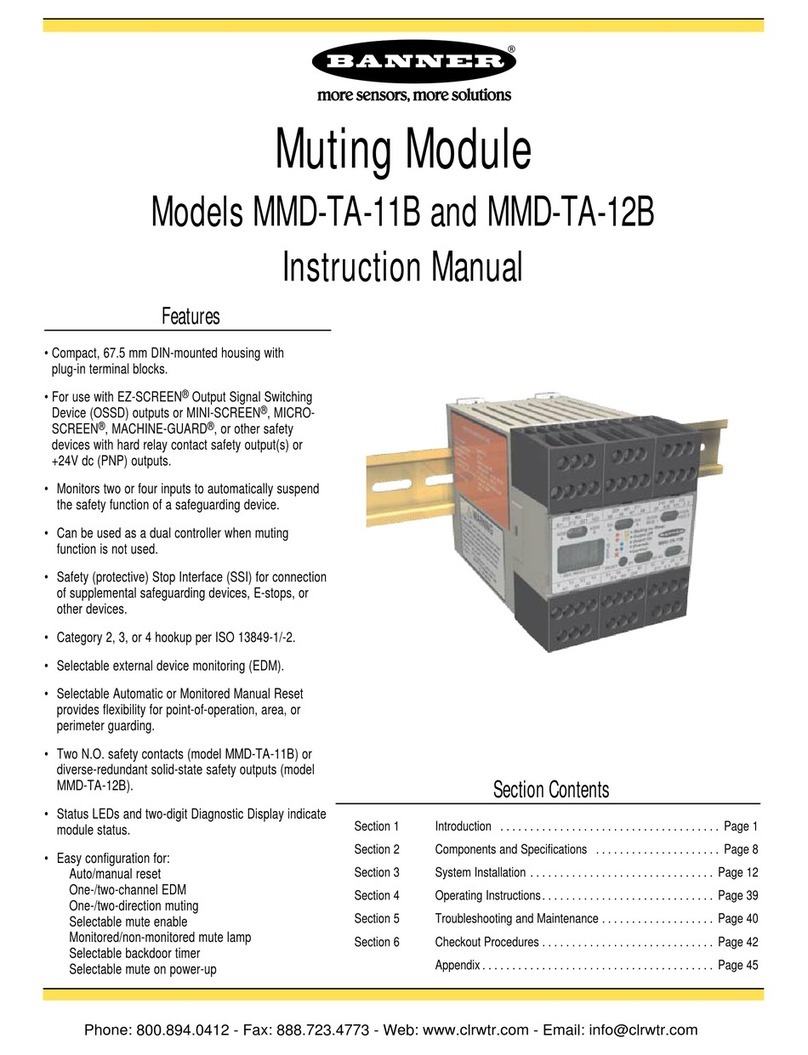
Banner
Banner MMD-TA-11B instruction manual
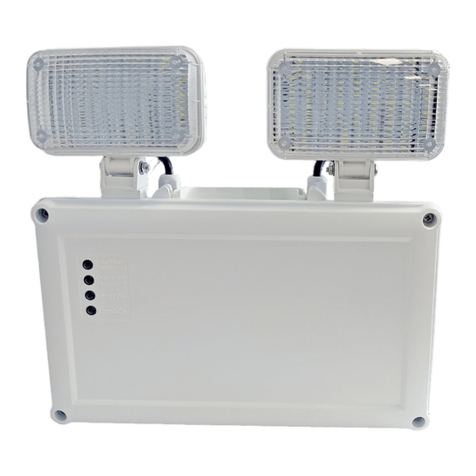
RICOMAN
RICOMAN Gemini installation instructions

Schnick-Schnack-Systems
Schnick-Schnack-Systems DMX-Recorder user guide

Honeywell
Honeywell VR400 Series operating instructions
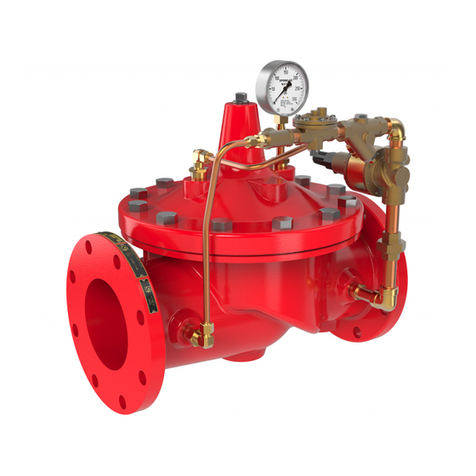
CLA-VAL
CLA-VAL 50B-4KG1 Installation, operation and maintanance manual

KEUCO
KEUCO 59948 000070 Installation and operating instructions
